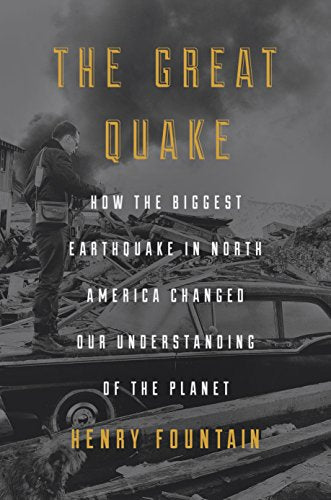Bargain Bin Books
The Great Quake: How the Biggest Earthquake in North America Changed Our Understanding of the Planet
Couldn't load pickup availability
Author: Fountain, Henry
Edition: 1st
Number Of Pages: 288
Details:
New York Times Book Review Editors' Choice • A riveting narrative about the biggest earthquake in North American recorded history—the 1964 Alaska earthquake that demolished the city of Valdez and swept away the island village of Chenega—and the geologist who hunted for clues to explain how and why it took place. At 5:36 p.m. on March 27, 1964, a magnitude 9.2. earthquake—the second most powerful in world history—struck the young state of Alaska. The violent shaking, followed by massive tsunamis, devastated the southern half of the state and killed more than 130 people. A day later, George Plafker, a geologist with the U.S. Geological Survey, arrived to investigate. His fascinating scientific detective work in the months that followed helped confirm the then-controversial theory of plate tectonics. In a compelling tale about the almost unimaginable brute force of nature, New York Times science journalist Henry Fountain combines history and science to bring the quake and its aftermath to life in vivid detail. With deep, on-the-ground reporting from Alaska, often in the company of George Plafker, Fountain shows how the earthquake left its mark on the land and its people—and on science.
Reviews:
"Interleaving snapshots of a lost world, the primal power of nature and high science, "The Great Quake" is an outstanding work of nonfiction." -- The Los Angeles Times "...as elegant as the score of a Beethoven symphony." -- Nature
About the Author:
HENRY FOUNTAIN has been a reporter and editor at the New York Times for two decades, writing about science for most of that time. From 1999 to 2009 he wrote "Observatory," a weekly column in the Science Times section. He was an editor on the national news desk and the Sunday Review and was one of the first editors of Circuits, the Times' pioneering technology section. Prior to coming to the Times, Fountain worked at the International Herald Tribune in Paris, New York Newsday, and the Bridgeport Post in Connecticut. He is a graduate of Yale University, where he majored in architecture. He and his family live just outside of New York City. Learn more at henry-fountain.com. Excerpt. © Reprinted by permission. All rights reserved. ***This excerpt is from an advance uncorrected copy proof*** Copyright © 2017 Henry Fountain Chapter 1: ALTERED STATE Riding shotgun beneath the clouds in a rattling De Havilland Otter, George Plafker gazed down upon an Alaska he’d never seen before. A geologist with the US Geological Survey, at the age of thirty-five Plafker was already something of an old Alaska hand. Though he was based at the Survey’s offices in Menlo Park, California, south of San Francisco (and with his wife, Ruth, had a modest house nearby where they were raising their three children), as a field geologist with its Alaska branch Plafker had spent many summers in the forty-ninth state. He was accustomed to exploring the back country for days at a time with little more than a rock hammer and a field notebook, some C rations to stave off hunger and a gun to ward off bears, studying and mapping rock formations to better understand, describe and catalog the state’s immense mineral resources. To a degree Plafker even looked the part of an Alaskan sourdough, lean and solid with a shock of wavy black hair swept behind half-moon ears, brown eyes and a large nose above a nothing-fancy mustache. His huge hands looked as if they’d be more at home holding a lumberjack’s ax or prospector’s shovel than a compass and hand level. In his time in Alaska, Plafker had come to realize he didn’t much care for the vast tundra of the central and northern parts of the state. Much of this land was what the Russians had named taiga: the boreal forest, thick with conifers and willows and birches and, to his mind at least, essentially impenetrable. Even if you could somehow get around the terrain, interior Alaska was boring, geo- logically speaking. You ...
EAN: 9781101904060
Release Date: 08-08-2017
Languages: English
Item Note: Great shape- pages are unmarked and sharp.Has a remainder mark. Hardcover Used - Like New Ships fast! 20171st
Item Condition: UsedLikeNew
Binding: Hardcover
Share


